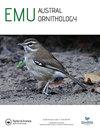Haemosporidian parasite diversity in an under-surveyed Australian avifauna
IF 1.1
4区 生物学
Q3 ORNITHOLOGY
引用次数: 0
Abstract
ABSTRACT Haemosporidian parasites of birds are geographically widespread, have been detected in a phylogenetically diverse array of hosts, and have been the focus of extensive research due to both their impacts on birds and their similarity to vector-borne diseases of humans. Advances in molecular diagnostic tools have created a greater awareness of the genetic diversity of haemosporidian infections. Yet in spite of their more or less global distribution, comparatively little is known about the haemosporidians affecting birds in Australia. We screened blood from 889 birds (23 species) for haemosporidian blood parasite infections during the 2019 breeding season at Brookfield Conservation Park, South Australia. We examined the genetic (lineage) diversity of haemosporidian infections in this behaviourally and ecologically diverse host assemblage and examined the congruence between parasite and host phylogenies. We identified seven Haemoproteus mitochondrial cytochrome b lineages, five of which were novel. Four birds had simultaneous co-infections by two Haemoproteus lineages each. The Haemoproteus lineages clustered at the host family level. Two Plasmodium lineages were also identified, each of which had been previously detected in different avian host species in Australasia. We did not detect any Leucocytozoon infections in our sample. This study supplies critical baseline data on host–parasite associations in a poorly-surveyed geographic region.未充分调查的澳大利亚鸟类中的血孢子虫寄生虫多样性
鸟类血孢子虫寄生虫在地理上分布广泛,已在多种宿主中检测到,由于其对鸟类的影响以及与人类媒介传播疾病的相似性,已成为广泛研究的焦点。分子诊断工具的进步使人们对血孢子虫感染的遗传多样性有了更大的认识。然而,尽管它们或多或少地分布在全球,但相对而言,人们对影响澳大利亚鸟类的血孢子虫知之甚少。2019年繁殖季节,我们在南澳大利亚布鲁克菲尔德保护公园对889只鸟(23种)的血液进行了血孢子虫血寄生虫感染筛查。我们在这种行为和生态多样化的宿主组合中检查了血孢子虫感染的遗传(谱系)多样性,并检查了寄生虫和宿主系统发育之间的一致性。我们鉴定了7个血红蛋白线粒体细胞色素b谱系,其中5个是新的。四只鸟同时感染了两种嗜血杆菌。血红蛋白谱系聚集在宿主家族水平。还确定了两种疟原虫谱系,每一种谱系以前都在澳大拉西亚不同的鸟类宿主物种中被发现。在我们的样本中没有检测到任何白细胞感染。这项研究提供了在一个调查不充分的地理区域的宿主-寄生虫关联的关键基线数据。
本文章由计算机程序翻译,如有差异,请以英文原文为准。
求助全文
约1分钟内获得全文
求助全文
来源期刊

Emu-Austral Ornithology
生物-鸟类学
CiteScore
2.00
自引率
7.70%
发文量
33
审稿时长
>12 weeks
期刊介绍:
Emu – Austral Ornithology is the premier journal for ornithological research and reviews related to the Southern Hemisphere and adjacent tropics. The journal has a long and proud tradition of publishing articles on many aspects of the biology of birds, particularly their conservation and management.
 求助内容:
求助内容: 应助结果提醒方式:
应助结果提醒方式:


